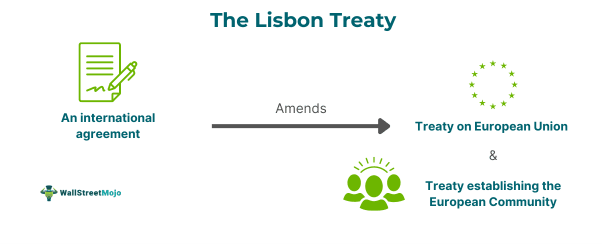Table of Contents
What Is The Lisbon Treaty?
The Lisbon Treaty refers to the international agreement establishing and recognizing the European Union as a legal entity. Its purpose is to centralize and introduce a legal framework for countries that wish to leave the union, along with updating new policies and regulations.

It was signed in Lisbon, Portugal, in the presence of European Parliament president Hans-Gert Pöttering, and is named after the location. Twenty-seven countries signed the treaty on December 13, 2007. It came into effect two years later, in December 2009, amending the two previous treaties, the Treaty of Rome and the Maastricht Treaty.
Key Takeaways
- The Lisbon Treaty is the official agreement between 27 countries to enact new policies and devise a processed framework for nations wishing to leave the European Union.
- It recognized the EU as a legal entity with the power to sign treaties in the regions where it held power; however, the member countries were only allowed to sign treaties compatible with the EU laws.
- The treaty came into force on December 1, 2009, after the ratification from all 27 member states.
- The treaty replaces the constitutional treaty that was rejected to form a union constitution.
Lisbon Treaty Explained
The Lisbon Treaty is the official agreement of 27 countries accepting the European Union as a legal personality, becoming its member state, and following its laws and regulations. The treaty elaborates on three important principles: participatory democracy, democratic equality, and representative democracy. The treaty replaced the term community with the word union in all documents. The Lisbon Treaty has no formal union law like a constitution but clarifies the union's power.
The most important aspect of the treaty was to establish a proper framework and procedure for countries willing to withdraw their membership from the European Union. The Lisbon Treaty is celebrated as a well-guided update that enhances democracy and protects the fundamental rights of the European people. The treaty also allows the member states to amend new rules and regulations according to changing times and requirements. It worked on creating a better European space and making people aware of human rights and practices.
The Lisbon Treaty had newly drafted rules giving new powers to the European Parliament and equality with the Council of Ministers in making monetary decisions with proper knowledge about the expenses. The treaty has brought the member states together and built solid political relationships internally and externally.
History
Before the Lisbon Treaty, there were two existing treaties. The Rome Treaty, signed in 1957, minimized customs regulations and established the European Economic Community and transportation laws. It followed the second treaty, the Maastricht Treaty, signed in 1992, which set the three pillars of the EU and introduced the concept of the common currency. These two treaties worked as a foundation for the EU, and then the Lisbon Treaty brought new rules and regulations with proper frameworks and devised procedures.
The EU Lisbon Treaty started as a constitutional project in 2001. The European Convention drafted the treaty establishing a European constitution for two years, until 2003. The treaty was subject to two referendums in May and June 2005, but the council adopted a detailed mandate under the Portuguese presidency, as stated in the March 2007 Berlin declaration.
The IGC concluded the work in 2007, and finally, the treaty was signed at the European Council of Lisbon and approved by all member states. Yet it took two years for it to come into force, and it finally was active on 1 December 2009.
Impact
- The treaty worked towards bringing the people of Europe closer and making it secure for everyone in it.
- Along with a legal personality, the Lisbon Treaty provided a new status and power to the European Union with international and regional organizations, including the UN.
- The EU Lisbon Treaty worked to enact and penetrate new EU policies in areas that require the most attention.
- The treaty built a new relationship bridge and opportunities for the Council of Europe and the European Union based on comparative advantages and common goals.
- It worked for the human rights policies and democratic laws in Europe.
- Devised a framework for voluntary withdrawal for the member states wishing to leave the European Union.
- Updated the regulations and amended new laws and the previous two treaties.
Ratification
All 27 member states must agree to the Lisbon Treaty for it to be ratified. On December 3, 2009, after all the member states had signed the Lisbon Treaty, the Czech Republic made the final signature through its president.
On 12 June 2008, 53% of Irish voters voted against the Lisbon Treaty. On 20 June 2008, the European Council decided that the ratification process must continue in other member countries while the Czech Republic reserved its position.
In December 2009, the European summit in Brussels announced that the Lisbon Treaty Ireland should come back with ratification in 2009 to let the treaty come into effect from January 2010. As per Article 30 of the Geneva Convention, the member countries are not allowed to continue ratification when or if a member state rejects it. The treaty will only be given significance and legality once all the states have ratified.
One hundred members of the Future Europe convention proposed that each member state adopt an EU constitution by referendum before its ratification. The process stalled after a decision to establish a pause for debate and dialogue. Sixteen member states, representing 37% of the European voters, ratified. After the reflection period, the prime ministers removed the Lisbon Treaty's major content from the constitution to avoid referendums.
